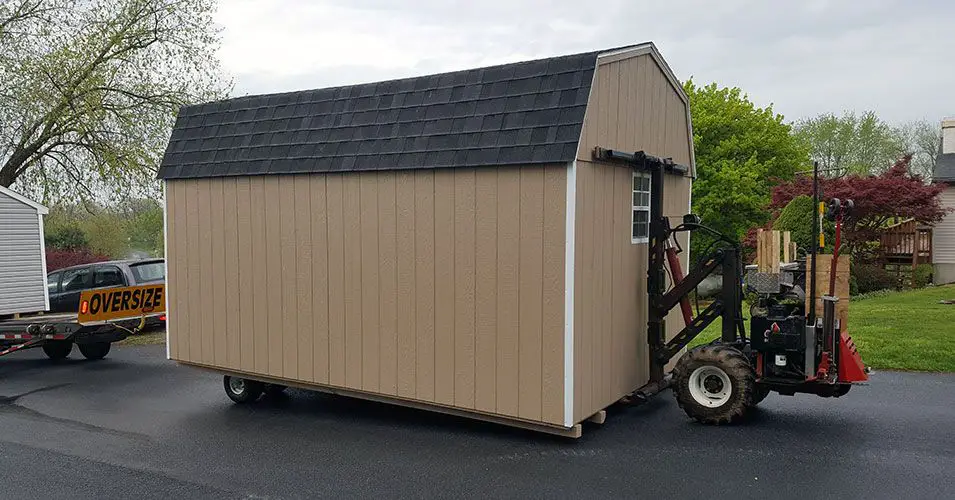Moving a storage shed can seem like a daunting task, but with some planning and preparation, it can actually be a relatively straightforward process. The key is having the right tools, equipment, and help to make the job easier. Here are some tips on how to move a storage shed with minimum hassle.
Page Contents
Assess the shed and route
First, take a good look at the shed itself – note its size, weight, materials, and current condition. Measure any tight spaces like gates or passages it will need to fit through. Knowing the shed’s specs and your route will determine how much disassembly is required and what type of transportation method to use.
Some questions to ask:
- What are the shed’s dimensions?
- Is it a heavy wooden shed or lighter metal/resin shed?
- Does it have a floor? Some sheds can be dragged if floorless.
- Are there any protruding parts that need removing?
- Can it fit through any gates or tight spaces when moving it?
Also assess the relocation route – are there steps, steep slopes, or obstacles to navigate around? Take measurements of any narrow passageways. Knowing the route will help plan the path of least resistance.
Choose your moving method
The shed’s size and weight will dictate how you move it. Here are some common options:
Dragging
For small, light sheds under about 4 x 6 ft, dragging along the ground is an option. This may require 2+ people. You can place furniture sliders or rolling logs underneath to reduce friction.
Lifting and carrying
A few strong people can lift and carry a small shed short distances. Make sure to lift from the base, bending knees to avoid injury.
Dolly or hand truck
A heavy duty dolly with straps can wheel some medium-sized sheds up to 500lbs for short distances. Use care on slopes or steps.
Trailer
For larger sheds, renting a trailer to tow behind a vehicle is often the easiest method. Use ratchet straps to secure the shed to the trailer bed.
Crane service
Hiring a crane company is the best option for moving very large or overweight sheds long distances. While expensive, it takes the heavy lifting out of your hands.
Compare all options and get help – moving a shed solo is difficult. Aim to use the simplest transportation method that gets the job done safely.
Prepare the shed for transport
To get a shed ready to move, follow these tips:
Remove doors, windows, roof
Detach any protruding doors, windows, roof panels or overhangs if needed to fit through narrow spaces.
Disconnect electricity and plumbing
If wired for electricity, shut off power and disconnect wiring. For plumbed sheds, disconnect any water lines or drains.
Clear out contents
Empty the shed completely – the lighter the load, the easier the move. Box and label contents so they can be easily relocated later.
Secure loose parts
Use tape, straps or temporary supports to secure any loose panels, hardware or parts that could shake loose when moving.
Prep the frame
For sheds with floors built on skids, ensure skids are in good condition. You may need to shim loose skids or replace broken ones prior to dragging.
Check for any parts on the shed base that could catch when dragged – remove protruding bolts/screws or use temporary covers to create a smooth surface.
Build ramps
For loading the shed onto a trailer or truck bed, build sturdy wood ramps. Make sure ramps are long enough to keep the angle low.
Transport the shed safely
When moving day arrives, make safety the top priority:
- Have helpers for both loading and unloading – don’t move a heavy shed solo.
- Use proper lifting techniques like keeping back straight and bending knees when carrying.
- If using ratchet straps, make sure shed is tightly secured to trailer bed.
- Drive slowly and avoid sudden acceleration/braking when towing.
- Watch for low hanging wires, branches when driving a tall shed on trailer.
- Use spotters to check clearances if squeezing through any tight spaces.
- Work slowly on ramps and slopes – rushing increases risk of slips and falls.
- Wear protective gloves when dragging sheds by hand to avoid slivers.
Taking it slow and careful is key – don’t rush the moving process if it risks damage or injury. If needed, divide the move into multiple days.
Position and reassemble the shed
When you reach the new location:
- Clear and level the area where the shed will sit. Gravel or pavers can help level the surface.
- Carefully unload/position the shed in its new spot, adjusting as needed.
- Anchor the shed securely to the ground again.
- Reattach any parts like doors, windows and roof panels.
- Reconnect any electrical and plumbing lines.
- Touch up any scratches or damage from the move.
Finally, move your contents back into the shed and do a final check that everything is properly assembled and secured.
Conclusion
Moving a storage shed is a project that requires careful preparation, the right equipment for the job, and helpers for the heavy lifting. Breaking the move into multiple stages helps reduce risk of damage. Patience and proper techniques are key – don’t rush any steps that could lead to injury or accidents. With some planning and help, relocating a shed can be managed smoothly.
